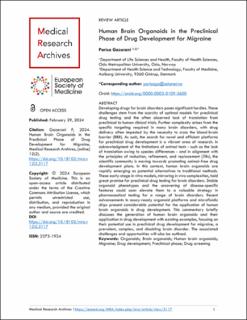| dc.description.abstract | Developing drugs for brain disorders poses significant hurdles. These
challenges stem from the scarcity of optimal models for preclinical
drug testing and the often observed lack of translation from
preclinical to human clinical trials. Further complexity arises from the
specific targeting required in many brain disorders, with drug
delivery often impeded by the necessity to cross the blood-brain
barrier (BBB). As such, the search for novel and efficient platforms
for preclinical drug development is a vibrant area of research. In
acknowledgment of the limitations of animal tests - such as the lack
of translation owing to species differences - and in alignment with
the principles of reduction, refinement, and replacement (3Rs), the
scientific community is moving towards promoting animal-free drug
development plans. In this context, human brain organoids are
rapidly emerging as potential alternatives to traditional methods.
These early-stage in vitro models, mirroring in vivo complexities, hold
great promise for preclinical drug testing for brain disorders. Stable
organoid phenotypes and the uncovering of disease-specific
features could soon elevate them to a valuable strategy in
pharmaceutical testing for a range of brain disorders. Recent
advancements in assay-ready organoid platforms and microfluidic
chips present considerable potential for the application of human
brain organoids in drug development. This commentary briefly
discusses the generation of human brain organoids and their
application in drug development with existing examples, focusing on
their potential use in preclinical drug development for migraine, a
prevalent, complex, and disabling brain disorder. The associated
challenges and opportunities will also be outlined. | en_US |

